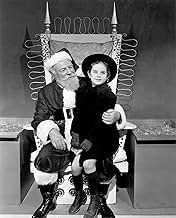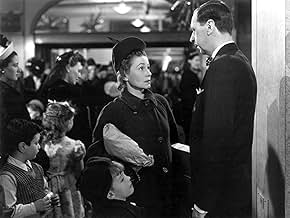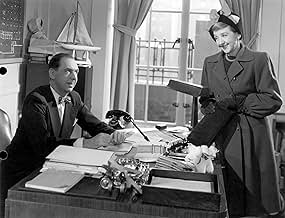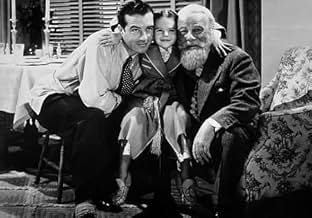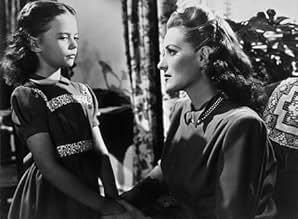Als ein netter alter Mann, der behauptet, der Weihnachtsmann zu sein, als geisteskrank eingeliefert wird, beschließt ein junger Anwalt, ihn zu verteidigen und argumentiert vor Gericht, dass ... Alles lesenAls ein netter alter Mann, der behauptet, der Weihnachtsmann zu sein, als geisteskrank eingeliefert wird, beschließt ein junger Anwalt, ihn zu verteidigen und argumentiert vor Gericht, dass er der echte Weihnachtsmann ist.Als ein netter alter Mann, der behauptet, der Weihnachtsmann zu sein, als geisteskrank eingeliefert wird, beschließt ein junger Anwalt, ihn zu verteidigen und argumentiert vor Gericht, dass er der echte Weihnachtsmann ist.
- Regie
- Drehbuch
- Hauptbesetzung
- 3 Oscars gewonnen
- 10 Gewinne & 1 Nominierung insgesamt
- Post Office Mail Sorter Next to Lou
- (Nicht genannt)
- Mr. R.H. Macy
- (Nicht genannt)
- Courtroom Spectator
- (Nicht genannt)
- Mrs. Shellhammer
- (Nicht genannt)
- Courtroom Spectator
- (Nicht genannt)
- Judge's Clerk
- (Nicht genannt)
- Child on Santa's Lap
- (Nicht genannt)
- Secretary
- (Nicht genannt)
- Department Store Head
- (Nicht genannt)
Empfohlene Bewertungen
I love movies like this for the insight they provide into the customs of a lost era. Watch the clothing - everybody is so dressed up! - women in dresses, gloves, and hats, men in hats and suits. Notice that when O'Hara enters a room filled with Macy's executives, even though they are the bosses and she is lower management, they all stand up instantly.
The social satire, most on display in the courtroom scenes, also is very 1940s. Apparently audiences of that era took a kind of genial corruption in the judicial system in stride. Business leaders, like "Mr. Macy" were expected to be sharp and profit-oriented, but also decent people like the rest of us. It's a much more nuanced view than the "businessman as criminal villain" so common in today's movies.
The character played by Maureen O'Hara probably needs explanation for modern viewers. Late 1940s audiences knew that the social and economic situation of a divorced working woman with a child was much more precarious than it is now. Divorce was still somewhat shocking - this is brought out neatly in the movie when her would-be lover does a double take when he learns from her daughter about the divorce - he probably had assumed she was a war widow. Divorced moms were still rare in the middle classes. Society universally agreed that women should stay home to raise their children. Economically, women in management positions were still very rare, couldn't expect promotion, and were last hired, first fired. I think O'Hara's performance brings out these qualities in a way that the audience of the 1940s would have understood easily. The character's stiffness, fear of losing control, and anxiety about her job make a great deal of sense. It would have been nice to see a few scenes showing her loosening up, perhaps at dinner with her boyfriend; no doubt those got left on the cutting room floor.
I really like the scene where Santa talks to the little Dutch orphan. First, this scene also must have resonated with the audience; in 1947 the western European countries had only started to recover from World War II, and probably many Americans were familiar with the idea of adopting a war orphan, just as many sent CARE packages. Second, by making Santa fluent in Dutch, the writer cleverly left the viewer thinking that hey, he might really be Santa Claus (isn't Santa Claus fluent in all languages)?
Some reviewers don't like the acting and think that modern actors are "better". I think the older actors aren't better or worse, just different. The audiences of the 1940s expected a certain style of acting, and the directors and actors gave that to them. Then as now, Hollywood paid top dollar and got very talented people, but like all of us they were shaped by their own time and place, more particularly the requirement to make movies that audiences would like. Move Maureen O'Hara to 2004, or Tom Cruise to 1947, and you'd see them acting in the style of that decade.
Frankly, in view of the fact that much of "Miracle" had already been shot on location in Macy's New York City store (to say nothing of the fact that studio heads of that era -- or any era, for that matter -- were notoriously prone not to take such financial risks), this "legend" is likely just so much "hype," otherwise known as "nonsense."
Thankfully, this is the only trace of phoniness attached to this jewel of a movie. "Miracle On 34th Street" is just that, in every sense of the word: a miracle.
Take a perfectly-crafted, thoughtful screenplay. Add an impeccable cast (from top-to-bottom, by the way; catch, just as one example, Thelma Ritter's uncredited turn as "Peter's Mother"). Throw into this mix an on-location "shoot" (along with Macy's, there's the store's actual 1946 Thanksgiving Parade, footage in a post office facility and a courthouse) which gives this film a nice sense of verisimilitude . . . just in case you're not already prepared (courtesy of Edmund Gwenn, in a totally-deserved Oscar-winning performance) to recapture your belief in Santa Claus.
"Miracle On 34th Street" is many things: a celebration of the Christmas spirit, a heartfelt plea against the "over-commercialism" (even in 1947)of Christmas, an examination of faith itself . . . just to name a few.
It works on every level. Every bit as well today, 54 years after its initial release, as then. Don't waste your time with the remakes -- both on TV as well as theatrical productions (and the less said about an abortive 1963 Broadway musical adaptation, "Here's Love," the better.)
Go for the original film. Go for the genuine article. Again and again and again.
PLEASE BEWARE OF SOME REVIEWERS THAT ONLY HAVE ONLY ONE REVIEW. I HAVE OVER 400 REVIEWS OF "CHRISTMAS RELATED FILMS & SPECIALS" WHEN ITS A POSITIVE THERE IS A GOOD CHANCE THEY WERE INVOLVED WITH THE PRODUCTION. NOW I HAVE NO AGENDA! I REVIEW MOVIES & SPECIALS AS A WAY TO KEEP TRACK OF WHAT I HAVE SEEN! I HAVE DISCOVERED MANY GEMS IN MY QUEST TO SEE AS MANY " C H R I S T M A S " MOVIES AS I CAN.
Now Someone keeps reporting my reviews. I guess they are jealous because I do tell the truth. I want to point out that I never make snide remarks about actors weight or real life sexual orientation. If there acting is terrible or limited "I talk about that". If a story is bad "I will mention that" So why am I being "picked on"? IMDB? When one of my reviews gets deleted IMDB will not even tell me what someone found offensive. Well on to this review.
Kris Kringle (Edmund Gwenn) is indignant to find that the man (Percy Helton) assigned to play Santa in the annual Macy's Thanksgiving Day Parade is intoxicated. When he complains to event director Doris Walker (Maureen O'Hara), she persuades Kris to take his place. He does so well, he is hired to play Santa at Macy's flagship New York City store on 34th Street.
Ignoring instructions to steer parents to buy from Macy's, Kris directs one shopper (Thelma Ritter) to a competitor. Impressed, she tells Julian Shellhammer (Philip Tonge), head of the toy department, that she will become a loyal customer.
Attorney Fred Gailey (John Payne), Doris's neighbor, takes the young divorcée's daughter Susan (Natalie Wood) to see Santa. Doris has raised her to not believe in fairy tales, but Susan is shaken after seeing Kris speak Dutch with a girl who does not know English. Doris asks Kringle to tell Susan that he is not Santa, but he insists that he is.
Worried, Doris decides to fire him. However, Kris has generated so much positive publicity and goodwill for Macy's that Macy (Harry Antrim) promises Doris and Julian bonuses. To alleviate Doris's misgivings, Julian has Granville Sawyer (Porter Hall) administer a "psychological evaluation". Kris passes, and questions Sawyer's own mental health.
This is a great film that everyone should see.
Gwenn, who played many solid character roles, gets the chance here to play a role for which he was ideally suited, and it works very well. O'Hara and Wood make a good pair to balance him out. The supporting cast gets some very good moments of their own, especially Gene Lockhart and William Frawley, whose scenes are entertaining while also offering some occasionally pointed commentary.
The style of the production is well-suited to the material, offering an innocently upbeat story without overdoing it on sentimentality. For all that this style of the production and acting are out of fashion, they are able to capture a theme like this in a worthwhile way that is simply not possible with the kind of false "sophistication" that permeates so many present-day movies.
That's not to say that this is some kind of masterpiece, which it is not and did not try to be. Instead, it's a light, enjoyable, positive movie that does make a worthwhile point or two. That kind of feature will always find an appreciative audience somewhere.
Wusstest du schon
- WissenswertesIn the untranslated dialogue with the Dutch girl, Kris asks her what she wants for Christmas. She says she wants nothing, telling him she got her gift by being adopted by her new mother.
- PatzerKris claims that John Quincy Adams' Vice-President was Daniel D. Tompkins; actually, it was John C. Calhoun. Tompkins served under James Monroe from 1817-1825. The confusion likely occurred because Adams was the 6th President, whereas Tompkins was the 6th Vice-President, as Thomas Jefferson and James Madison had three Vice-Presidents between them.
- Zitate
Mr. Shellhammer: But... but maybe he's only a little crazy like painters or composers or... or some of those men in Washington.
- Crazy CreditsThe film's credits do not contain the standard "All characters and events are fictional..." disclaimer, leaving many people to believe that this was a true story.
- Alternative VersionenAlso available in two computer colorized versions. The film was first colorized in 1985 by Color Systems Technology, Inc. and again in 2006 by Legend Films using much-improved technology. Prints came with a disclaimer: "It has been altered without the participation of the principal director, screenwriter and other creators of the original film."
- VerbindungenFeatured in The Screen Writer (1950)
- SoundtracksJingle Bells
(1857) (uncredited)
Written by James Pierpont
Played at the announcement of the parade
Played occasionally in the score
Sung a cappella a bit by Percy Helton and later by Jack Albertson
Top-Auswahl
- How long is Miracle on 34th Street?Powered by Alexa
Details
- Erscheinungsdatum
- Herkunftsland
- Sprachen
- Auch bekannt als
- De ilusión también se vive
- Drehorte
- 24 Derby Road, Port Washington, Long Island, New York, USA(Susan's dream house)
- Produktionsfirma
- Weitere beteiligte Unternehmen bei IMDbPro anzeigen
Box Office
- Weltweiter Bruttoertrag
- 3.851 $
- Laufzeit
- 1 Std. 36 Min.(96 min)
- Farbe
- Seitenverhältnis
- 1.37 : 1






